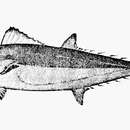Diagnostic Description
provided by Fishbase
Mouth relatively small, upper jaw reaching about to middle of eye. Pectoral fins stout. Interpelvic process short and single. No prominent anterior corselet present. Swim bladder present. Vertebrae 14 precaudal plus 17 caudal, total 31 as in mackerel (Scomber and Rastrelliger).Description: Characterized further by metallic blue-green, shading to silvery below; three keels on caudal peduncle and fin base, middle one largest; most of head and body covered with small scales; two lateral lines, second branching from first below third dorsal spine, passing ventrally along body, rejoining first below last dorsal finlet; large eye, 7-9% of fork length; maxilla reaching below middle of eye; jaws with 20-30 slender conical teeth; vomer and palatines with a patch of small teeth; maximum weight about 3.5 kg (Ref. 90102).
Migration
provided by Fishbase
Oceanodromous. Migrating within oceans typically between spawning and different feeding areas, as tunas do. Migrations should be cyclical and predictable and cover more than 100 km.
Morphology
provided by Fishbase
Dorsal spines (total): 11 - 13; Dorsal soft rays (total): 10 - 14; Analspines: 0; Analsoft rays: 10 - 14
Biology
provided by Fishbase
Inhabits open water but often seen swimming near outer reef walls or deep clear-water slopes (Ref. 48637). Found mostly in shallow reef waters where it forms large schools. Feeds on crustaceans and fishes, particularly clupeoids (Sardinella, Thrissocles), and other fishes such as Sphyraena and Balistes. Marketed canned and frozen (Ref. 9684). Its flesh is mild and pleasantly flavored, but brushed with lemon juice prior to cooking to remove the ammonia-like smell (Ref. 9684).
Importance
provided by Fishbase
fisheries: minor commercial; gamefish: yes; price category: very high; price reliability: very questionable: based on ex-vessel price for species in this family
分布
provided by The Fish Database of Taiwan
分布於印度-西太平洋之溫暖水域。台灣主要產於東部海域。
利用
provided by The Fish Database of Taiwan
一般漁法以流刺網或延繩釣捕獲。主要以加工製成罐頭為主,為次要經濟性魚種。
描述
provided by The Fish Database of Taiwan
體延長,側扁;尾柄細短,平扁,兩側各具一發達的中央隆起脊,尾鰭基部兩側另具2條小的側隆起脊。頭中大,稍側扁。吻尖突。眼大,位近頭的背緣。口中大,端位,斜裂;上下頜等長,上下頜齒具強大而尖銳齒1列,腭骨及鋤骨齒細小呈齒區。第一鰓弓上之鰓耙數為19-24。體一致被細小圓鱗,無特別的胸甲鱗;左右腹鰭間具1小鱗瓣在胸鰭後端。側線2條,第一條沿背側平行延伸,伸達尾鰭基;第二條在胸鰭後方連接第一條側線後急速向下至腹面而延伸到體後部與第一條側線再相連。第一背鰭具硬棘XII,與第二背鰭起點距離近,其後具6-7個離鰭;臀鰭與第二背鰭同形;尾鰭新月形。體背側青黃色,腹側淺色。全世界此屬有4種,臺灣僅發現一種。
棲地
provided by The Fish Database of Taiwan
主要棲息於開放水域,大部分被發現成群於水淺的礁石區水域,但亦時常可見到遊泳於近外圍礁壁或較深且清澈水域的斜坡區。以甲殼動物和魚類為食,特別是鯡科及鯷科的魚,如沙丁魚與綾鯷等
Double-lined mackerel
provided by wikipedia EN
The double-lined mackerel (Grammatorcynus bilineatus), is a species of Spanish mackerel (tribe Scomberomorini) in the family Scombridae.[2][3] This species is sometimes also called the scad mackerel.[2]
Distribution and habitat
This species is present in the tropical and subtropical Indo-Pacific, from the Red Sea to the Andaman Sea, also from the northern coast of Australia to the Ryukyu Islands, as far as Fiji.[4]
Habitat
These subtropical reef-associated and oceanodromous fishes usually inhabit open water but they are mostly found in shallow waters at depths of 15 to 50 m.[4]
Description
Grammatorcynus bilineatus can reach a maximum length of about 100 centimetres (39 in), with a common length of about 50 centimetres (20 in) and maximum weight of about 3.5 kilograms (7.7 lb).[5][6]
The double-lined mackerel has an elongated and slightly compressed body covered with small flakes with a relatively small mouth and large eyes. The body color is dark blue on the back, silvery on the sides, silvery white on the belly. The dorsal fins are two, separated by a short space. These fishes have eleven- thirteen dorsal spines, ten- fourteen dorsal soft rays and ten-fourteen anal soft rays. The pectoral fins are rather short. There are two lateral lines, one on the dorsal profile, and the other at the height of the pectoral fins.[4][7]
Before 1983, this species was sometimes confused with Grammatorcynus bicarinatus, the shark mackerel.[1]
Biology
Grammatorcynus bilineatus mainly feed on crustaceans and fishes, especially Clupeiformes (Sardinella and Thryssa species), but also other fishes such as triggerfishes (Balistes) and barracudas (Sphyraena). It usually forms large schools.
Fisheries
The double-lined mackerel is a commercial fish, usually marketed canned and frozen.
Bibliography
- Fenner, Robert M.: The Conscientious Marine Aquarist. Neptune City, USA: T.F.H. Publications, 2001.
- Helfman, G., B. Collette y D. Facey: The diversity of fishes. Blackwell Science, Malden, Massachusetts, USA, 1997
- Hoese, D.F. 1986: . A M.M. Smith y P.C. Heemstra (eds.) Smiths' sea fishes. Springer-Verlag, Berlín.
- Maugé, L.A. 1986. A J. Daget, J.-P. Gosse y D.F.E. Thys van den Audenaerde (eds.) Check-list of the freshwater fishes of África. Vol. 2.
- Moyle, P. y J. Cech.: Fishes: An Introduction to Ichthyology, 4th. ed, Upper Saddle River, USA - Prentice-Hall. 2000.
- Nelson, J.: Fishes of the World, 3rd ed.USA: John Wiley and Sons. 1994.
- Wheeler, A.: The World Encyclopedia of Fishes, 2nd. Ed. London: Macdonald. 1985.
References
-
^ a b Collette, B.; Chiang, W.; Di Natale, A.; Fox, W.; Juan Jorda, M. & Nelson, R. (2011). "Grammatorcynus bilineatus". IUCN Red List of Threatened Species. 2011: e.T170358A6768577. doi:10.2305/IUCN.UK.2011-2.RLTS.T170358A6768577.en. Retrieved 30 November 2022.
-
^ a b "Grammatorcynus bicarinatus (Quoy & Gaimard, 1825)". Integrated Taxonomic Information System. Retrieved 9 November 2012.
-
^ WoRMS
-
^ a b c Froese, Rainer; Pauly, Daniel (eds.) (2005). "Grammatorcynus bilineatus" in FishBase. 10 2005 version.
-
^ Collette, B.B., 2001. - Scombridae. Tunas (also, albacore, bonitos, mackerels, seerfishes, and wahoo). - FAO species identification guide for fishery purposes. K.E. Carpenter and V. Niem (eds.)
-
^ Collette, B.B. and C.E. Nauen, 1983. - Scombrids of the world. An annotated and illustrated catalogue of tunas, mackerels, bonitos and related species known to date - FAO Species Catalogue. Vol. 2.
-
^ Collete, B.B. 1986. - Scombridae. - In P.J.P. White head, M.-L. Bauchot, J.-C. Hureau, J. Nielsen, and E. Tortonese (eds.), Fishes of the North-eastern Atlantic and the Mediterranea. Vol II, pp. 981-997. UNESCO, Paris

- license
- cc-by-sa-3.0
- copyright
- Wikipedia authors and editors
Double-lined mackerel: Brief Summary
provided by wikipedia EN
The double-lined mackerel (Grammatorcynus bilineatus), is a species of Spanish mackerel (tribe Scomberomorini) in the family Scombridae. This species is sometimes also called the scad mackerel.
- license
- cc-by-sa-3.0
- copyright
- Wikipedia authors and editors

